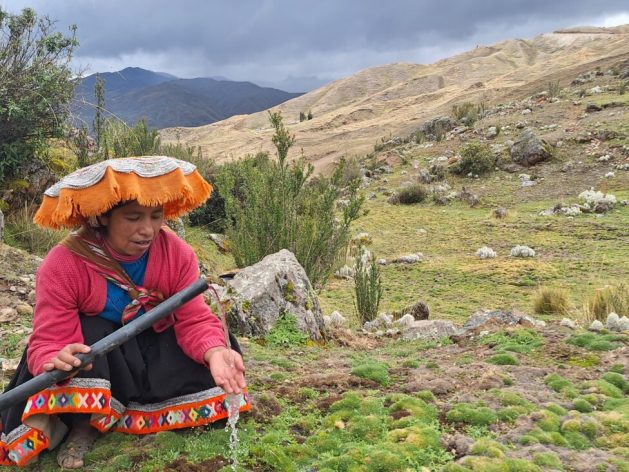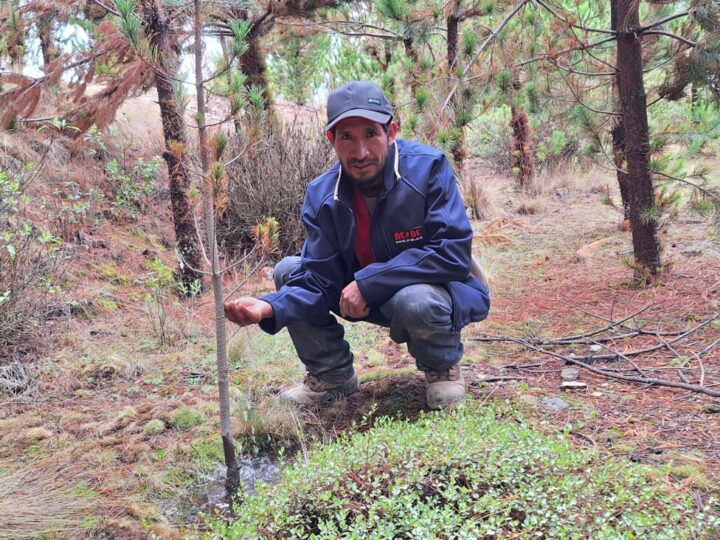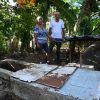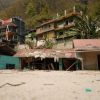Monday, April 29, 2024
News and Views from the Global South
Climate Change Justice
Peru’s Andean Peoples ‘Revive’ Water that the Climate Crisis Is Taking From Them

Before, when it didn't rain in the summertime, we children used to pray to God to send us water from the heavens, and the rain would come. But now it's different; the climate has changed and no prayers work—Juan Hilario Quispe, president of the small farming community of Muñapata

Juana María Quispe, a small farmer from the community of Sachac in the Andes highlands of the Peruvian department of Cuzco, is thrilled to see water flowing through a hose from the natural springs that have been revived through community work by building rustic dams, allowing the community's 200 families to mitigate the drought caused by climate change. Credit: Mariela Jara/IPS
- “The rich world has caused the climate change that is drying up our water sources, and here we are doing everything we can to recover them because otherwise we will die,” said Juan Hilario Quispe, president of the small farming community of Muñapata, just over 50 kilometers from the Peruvian city of Cuzco.
Located in Urcos, one of the 12 municipalities of the Cuzco province of Quispicanchi, the community is in an endless struggle against the permanent water shortage, one of the most devastating impacts of the climate crisis for those whose livelihoods depend on subsistence agriculture.
Peru, whose population of 33 million people is distributed along its coastal strip, the Amazon rainforest, and the Andes highlands, is one of the countries most vulnerable to climate change, and particularly Cuzco, the region known worldwide for being the cradle of the Inca empire.
In Cuzco, the population is close to 1.4 million and almost 40 percent of the people live in rural areas where family agriculture is one of the main economic activities and the lack of water is a direct threat to their livelihoods.
“Before, when it didn’t rain in the summertime, we children used to pray to God to send us water from the heavens, and the rain would come. But now it’s different; the climate has changed and no prayers work,” Quispe told IPS in the community center of Muñapata, located at 3,100 meters above sea level.
Peru is home to 68 percent of the planet’s tropical glaciers, more than half of which have been lost in the last 60 years due to climate change. The ones located in Cuzco have been among the hardest hit.
In addition, the southern Peruvian Andes highlands region of Cuzco has been experiencing a severe drought for the last two years, aggravated by the El Niño climate phenomenon, which is intensifying due to the global climate crisis.

Women and men from the community of Sachac, in the Peruvian municipality of Urcos in the Andes highlands of Cuzco, organized themselves to carry out communal tasks for more than eight hours a day in order to dig infiltration ditches as part of the works of planting and harvesting water, with which they reversed the absence of rainfall that hit them since 2021 and until the end of November this year. Credit: Courtesy of Marco Arango
In the face of the tangible consequences of climate change, the people of Muñapata decided to recover their water sources through the revival of ancestral Quechua practices known as sowing and harvesting water, which generate the conditions for part of the rain to be captured, stored, and infiltrated into the soil, preventing the water from running off and being lost.
This recharges aquifers that feed the diversity of natural water sources such as the ojos de agua—small natural pools of spring water—which in turn regenerate wetlands and pastures where animals can drink.
“We have planted more than 20,000 native plants that capture water in the headwaters of the watershed, and we have built infiltration ditches, or amunas (in the Quechua language), age-old irrigation ditches that allow water to seep into the subsoil, and recharge canals,” said Yolanda Haqqehua, leader of the community’s agroecological producers, affiliated with the Provincial Association of Agroecological Producers of Quispicanchi (APPEQ).
While pointing to the area where they planted queuñas (Polylepis ssp), a small tree native to the Andes highlands that is highly drought-resistant and valuable for trapping water from fog that then seeps into the soil, Haqqehua expressed her satisfaction with the first results of the work of her community, where some 300 families live.
“The seedlings are growing well, and we are bringing water from the ojo de agua for our own consumption with a hose. We are also going to be able to improve our crops after two very difficult years. But we have to keep fighting because the water problem will continue as long as we have this climate change issue,” she said.

Julián Cuti, secretary of the town council of the farming village of Sachac, located at 4,000 meters above sea level in the southern department of Cuzco, shows the vegetation cover generated by water infiltration, one of the small community works to respond to the growing water shortage in the Andes highlands of Peru. Credit: Mariela Jara/IPS
A Community Response Based on Equality
To learn about the community water revival projects, IPS accompanied members of the non-governmental Flora Tristán Peruvian Women’s Center on a tour of the trails of the Quechua small farming communities of Muñapata and Sachac, the latter located in the municipality of Quiquijana, also in the Cuzco province of Quispicanchi.
These are two of the three communities where the NGO provided technical assistance to the efforts of the local population to respond to the challenges of rising temperatures, which, according to the sixth report of the Intergovernmental Panel on Climate Change (IPCC), will hit Latin American countries hard in the coming years, despite the fact that the region is responsible for only five percent of global emissions.
“Climate justice is a path to be taken in our countries and specifically in rural and poor communities such as the ones we are visiting, where the populace is in a situation of greater vulnerability due to the characteristics of the territory they inhabit, poverty and neglect by the state, and gender inequality,” said Katherine Pozo, with the Flora Tristán Peruvian Women’s Center’s Rural Development Program.
She argued that in addition to ensuring that at climate summits such as the one held in Dubai this December, the richest countries give guarantees of their commitment to provide the funds required by the countries of the South, it is necessary to ensure that these resources are available to population groups according to their needs, differentiated by gender, age, territorial location, and other elements.
“There can be no climate justice without equity, without rights, without gender equality,” she said.

Yolanda Haqqehua, an agroecological farmer from the rural Quechua community of Muñapata in the southern Andes highlands of Peru, points out the areas where they planted queuñas, an altiplano tree highly adapted to capture water from the environment and infiltrate it into the soil through its roots—a contribution to combating the recurrent droughts caused by the climate crisis. Credit: Mariela Jara/IPS
Hence, women, particularly those involved in the production of vegetables and herbs using agroecological techniques, have played an important part in the development of the practices of planting and harvesting water.
It was women who played the strongest role in motivating the local governments in their communities to get involved in the revival of water sources, in an effort supported by the Basque Cooperation Agency and the Mugen Gainetik institution from the Basque country in northern Spain.
Agriculture is Impossible Without Water
After two years of drought that led the Peruvian government to declare the department in a state of emergency due to water stress, Cuzco has been receiving steady rains since the end of November. The traditionally sunny skies of the Andean highlands are often now suddenly covered by dense curtains of gray clouds.
This is good news for the people of Muñapata and Sachac, as they expect the cochas—the Quechua name for small earthen ponds—infiltration ditches, amunas and recharge canals to fill with water, allowing infiltration into the soil (water planting) and direct use for irrigation or daily consumption (water harvesting).
David Quispe, a community member from the Cunucunca area, near Muñapata, is president of the Forestation Committee and gets excited during a tour of the area when he sees little ponds full of water, huge mushrooms at the base of a ficus grove, and, above all, when he sees that the queuña trees are growing well.
“Community members have worked in a coordinated fashion to dig on the hillsides, to cut ditches across the altiplano, and to plant our native plants to revive the water that climate change is drying up with global warming,” he told IPS.

Community leader Juan Cuti looks with satisfaction at a green path where crystal-clear water runs along the edge of an area forested with queuña trees in the highlands of his community, Sachac, in the southern Peruvian department of Cuzco, protected by a wire fence. It is an example of work carried out collectively by villagers to cope with the impacts of climate change. Credit: Mariela Jara/IPS
He said he was born in 1978 and that when he was a child, he was able to graze the family’s sheep in different places because he could always find active springs and ojos de agua. “But they dried up little by little, and that is very bad for those of us who make a living from agriculture and grazing livestock,” he lamented.
He lives with and takes care of his elderly mother and father, works as a farmer, and is a community leader. His wish is that latent territorial disputes over water do not break out, and he is convinced that the solution is to ensure supplies for irrigation and domestic use. “That’s on my mind now,” he remarked.
A Consequence of Climate Change
Juana María Quispe was born in the community of Sachac and raised her family there with Julián Cuti. They have six children, three boys and three girls, ranging in age from four to 19. She speaks only Quechua and talks to IPS through interpretation by bilingual engineer Janet Nina, a member of the Flora Tristán Center.
At more than 4,000 meters above sea level, in the highest part of the community, she and her husband proudly show off the work done in long communal tasks, efforts in which all able local residents take part.
“The streams were drying up; climate change was leaving us without water, but now we are reviving it,” she said happily.

Peasant farmers from the area of Cunucunca, in the community of Muñapata in the southern Peruvian department of Cuzco, climb to more than 3,100 meters above sea level on their way back to their homes after having walked along different sections of the infiltration ditches reforested with native plants, initiatives carried out in response to the loss of their springs and other water sources due to climate change. Credit: Mariela Jara/IPS
In Sachac, home to some 200 families, the population has planted 10,500 queuña, chachacomo (Escallonia resinosa) and qolle (Buddleja coriácea) native water-collecting trees in an area that the community members have protected with a wire fence.
They have also built nearly 5,000 linear meters of infiltration ditches using local materials such as stones and mud blocks called champas.
“In the town council, we have made the commitment to maintain in good condition the works we have carried out and to demand that the authorities invest in forestation throughout the headwaters of Sachac and build more ditches, amunas, and cochas,” said Cuti, who is now secretary of the local community and was previously its president.
He reflected on the problem of not having rainfall when most of his agricultural production is on non-irrigated land and depends on rain.
“We know that this is a consequence of climate change and that it is up to us to be prepared so that life continues, not only for us but also for our children and grandchildren, and it is with them in mind that we are working so hard now,” added the community leader.
Quispe, his wife, pointed out that it was women farmers, as members of APPEQ, who demanded that the town council act in response to the climate change that deprived them of irrigation water for their biogardens. She also said that with persistence, they overcame the initial resistance to women’s participation in communal work.
“We women have carried the champas (roots), the stones, and the rocks; we have used the shovels and dug the soil as equals; we have dug the holes and planted the plants; and now it is only fair that we are also on par in the irrigation committees. Without discrimination and working together, we will be stronger in the face of climate change,” she said.

Small farmer Diego Quispe, from the community of Muñapata in the highlands of Cuzco in Peru’s southern Andes, is pleased with the water he finds on his way to the area of the infiltration ditches and reforestation carried out with communal work to revive water sources that have been increasingly lost. Credit: Mariela Jara/IPS
Enormous, Permanent Challenge
Engineer Flavio Valer, with 15 years of experience in the development of natural infrastructure for the recovery of water sources in the Andes highlands of Cuzco, said climate change has given rural communities a new, enormous, and permanent challenge.
In addition, he said it comes on top of other challenges that must be assumed as a result of the lack of public policies focusing on the sustainable development of these communities neglected by the state.
He stressed the importance of the local populace organizing themselves in contexts of poverty, disadvantage, and inequality to carry out work that, although it adds to their already heavy workdays, spells the difference between having a fundamental means of livelihood and not having one at all.
“With the planting and harvesting of water, which recovers the knowledge of our ancestors’ cultures, we make the water stay in the upper parts so that recharge occurs. We also make infiltration ditches where the soils are bare and thus retain the moisture, and water will sprout from the springs or increase its flow,” he explained.
And he remarked, “What we say to the water is don’t go down the hillside; stay here; the aquifers need you.”
This feature was made possible with the support of Open Society Foundations.
IPS UN Bureau Report

 Print
Print



